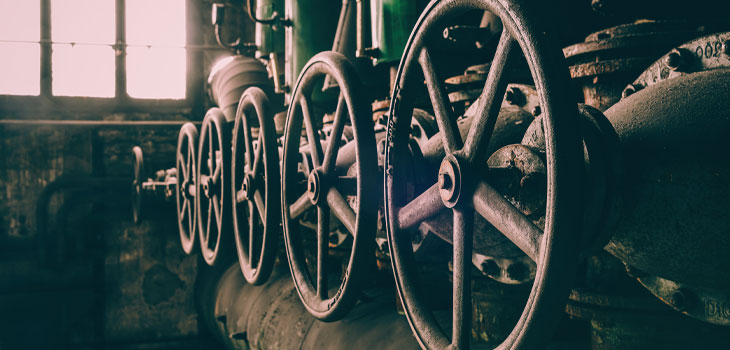Valves have come a long way from their beginnings, almost 2000 years ago. Technological advancements and human knowledge have continuously allowed new and improved designs to emerge in the valve industry. Technological advancements are paired with the need for valves to be better suited for the applications as industries need enhanced valves.
Historically, there are five critical eras of valve innovation, starting from 2000 years ago and leading up to the current day. We will take a trip down memory lane and cover these eras and the advancements made during them.
Rome
Roman civilization was no stranger to early engineering advancements. The availability of freshwater was restricted in ancient civilizations, but Rome found solutions to thrive. Rome is famous for its development of aqueducts which would move large volumes of water over a significant distance. Distribution of water became a responsibility of the Roman government, which was solved with the installation of waterworks system of lead pipe and bronze plug valves.
These plug valves were simple shut-off valves fabricated from bronze castings. Along with the municipal water systems, these plug valves were also attached to individual homes and businesses. These valves connecting to an individual’s residence were seen as a symbol of luxury, as something not many people could afford direct water access.
Check Valves were found in roman civilization as well. Hero of Alexandria invented a portable fire pump that could be rapidly deployed to fight fires. The manual operation of this pump relied on two check valves.
The Industrial Revolution
The Industrial Revolution began in England in the late 1700s and significantly impacted valve design and manufacturing. The boom in manufacturing and material production allowed valve manufacturers to expand their operations and improve their designs. New inventions like the steam engine were generating demand for valves that could handle higher pressures and temperatures.
Valves used for waterworks remained relatively low pressure, while steam applications continually increased operating pressures. In 1775, the Watts steam engine ran using 15 PSIG steam, by 1890, operating pressures had reached over 200 PSIG.
World War I
World War I brought standardization into the valve industry. The need to supply water to soldiers living in trenches and underground bunkers meant that as the trench lines moved, the water supply system had to be easily disassembled and re-configured and needed to be quickly repaired when damaged by artillery fire.
Industry-standard groups had risen in the past years and influenced the standards that valves would be governed by. These groups include:
• American Society for Testing and Materials (founded in 1898)
• American Water Works Association (founded in 1881)
• American National Standards Institute (founded in 1918)
Pipe sizes were rationalized with the framework of these groups, which ultimately led to flange and pipe thread dimensions being standardized. Nearly all present-day valve types incorporate materials and design changes that began with standardization in the 1910 to 1930 era. Technological improvements brought cast steel as the most common material for industrial valves, which have much higher pressure and temperature ratings than bronze cast valves.
World War II
World War II significantly increased the need for industrial valves. Refining oil to produce fuel for military purposes and synthetic rubber production ramped up during the war years, with refineries running at ever-increasing pressures and temperatures. US production of petroleum products grew from 3.5 million barrels of oil per day in 1939 to 4.8 million barrels per day in 1945.
The ever-increasing pressures and temperatures of oil production sparked the development of corrosion and heat-resistant metallic alloys. Along with this, the invention of pressure-seal bonnets was designed in response to high pressures and temperatures in steam applications.
The final key invention of this time was Teflon, which was an accidental discovery in 1938. Teflon has properties that make it ideal for many valve applications. It is chemically inert, can operate up to 500 °F, has very low friction and can be molded into complex shapes. Teflon was the final ingredient needed to bring valves into the nuclear age.
1950-2000
The biggest improvements during this era revolve around control systems improving with computers. Sensors would feed data to computer control systems at high accuracy, much faster than traditional monitoring. Electric actuators sped up the system as well, phasing away from pneumatic control. This was particularly useful to the booming industry of nuclear power, where speed was of the utmost importance.
In 1960s, the triple-offset butterfly valve design was introduced. The design included a resilient seat that offers zero leakage, with a metallic body and seat capable of operating at temperatures far above any available polymer or elastomer butterfly valve seats.
During the 1970s and 1980s, more improvements to controls systems were designed. There was a shift from analog control to digital control, which allowed for more complicated process control systems. These control systems led to more robust valves with sophisticated digital electronic control systems. Particularly, fieldbus communication systems allow operation and control of automated valves, which substantially cut the time to operate.
Conclusion
Valves are classic devices that have seen years of development behind them, from classical bronze plug valves in Rome to computer-controlled systems in nuclear power plants. There has always been a race for technology to overcome application restraints. This process of technology meeting demands is still happening today, with the latest improvements in valves focusing on severe service applications and exotic alloys.
